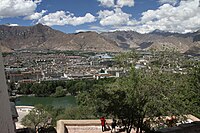
Photo from wikipedia
The valley plain of Lhasa City is located on the Qinghai-Tibetan Plateau, which is one of the most developed and densely populated areas in Tibet. Groundwater is an important water… Click to show full abstract
The valley plain of Lhasa City is located on the Qinghai-Tibetan Plateau, which is one of the most developed and densely populated areas in Tibet. Groundwater is an important water supply source and plays an irreplaceable role in the social and economic development of Lhasa City. This study has investigated the dynamic characteristics of groundwater in the valley plain of Lhasa City through the methods of mathematical statistics and hydrochemical analysis. The results showed that local topography, climate, and urbanization substantially influenced the groundwater dynamics. Under the combined influences from urbanization and climate, the groundwater level decreased over three time periods, but the groundwater-level configuration has not shown significant changes in over 15 years. From 1997 to 2015, the hydrochemical type of groundwater has changed from HCO3–Ca to HCO3·SO4–Ca·Mg and HCO3·SO4–Ca. The concentrations of Cl−, Mg2+, and SO42− in groundwater increased, but the concentrations of other ions were relatively stable. Water–rock interaction was the main mechanism controlling the groundwater chemistry in the study area, and it was mainly associated with the dissolution of silicate, carbonate, and halite.
Journal Title: Environmental Earth Sciences
Year Published: 2018
Link to full text (if available)
Share on Social Media: Sign Up to like & get
recommendations!